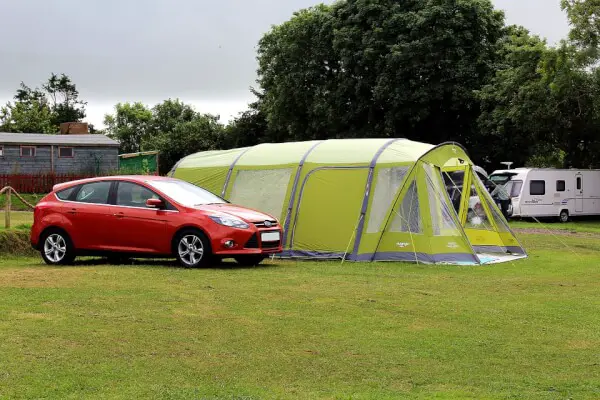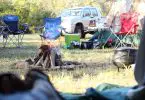With so many camping destinations to choose from, it can be hard to decide where to go. The American south is too often overlooked – but it holds some of the most beautiful and historic scenery in the entire country.
See also: Best Hikes in the World: 8 Hikes Worth Putting on Your Bucket List
Alabama in particular is home to several national monuments, national heritage areas, national forests, and state parks – as well as one of the biggest inland waterways in the U.S. Camping here is a one of a kind experience – usually complete with activities like hiking, fishing, s’mores assembling, and of course warm, sunny weather.
In this article, we’ll give you a run down of the 10 places to go for the best camping in Alabama, as well as their amenities and what activities are nearby. Get ready to plan your next trip to the heart of Dixie!
Oak Mountain State Park
Oak Mountain State Park is a beautiful, 10,000 acre park located just south of Birmingham. The scenery is one of the biggest draws to this destination, and the park offers everything from lakes to mountain views. 50 miles of trails mean that even avid hikers will have plenty to explore, and mountain bikers and horseback riders will have plenty to do as well.
Other perks to this park are its major migratory bird populations, nature programs, and demonstration farm. For the less naturally inclined, you can also take advantage of two BMX tracks, a golf course, and an archery range.
Oak Mountain is a large and well visited park – but it’s far from a commercial entity. The park partners with the Alabama Wildlife Center to rehabilitate native birds that have been injured in the wild and in cities. These rehabilitated birds are released back into the wild whenever possible – talk about natural stewardship!
The park also boasts an incredible interpretive center where visitors of all ages can learn about the wildlife, geography, and geology of the state interactively.
If you’re not already sold on Oak Mountain, let’s take it one step further. There are several camping options here – fit for any type of camper. Full service campgrounds are available on a reservation basis – these include vehicle hookups, electricity, water, and plumbing, as well as access to laundry and showers. For the more adventurous, backcountry sites are accessible by foot or horseback.
Cathedral Caverns State Park
If you’re looking for a camping experience that’s a little more “underground”, check out Cathedral Caverns. This state park features a massive natural cave that holds some seriously impressive wonders. From “Goliath”, a 45 foot stalagmite, to a solidified waterfall, this cavern is both beautiful and geologically amazing.
Visitors to the park can take advantage of guided tours of the cavern as well as unguided hiking throughout the rest of the park’s nearly 500 acres. Other activities include gemstone mining, backpacking, and birdwatching. Several lakes sit a short drive away for those who crave a little time on the water.
Cathedral Caverns offers several primitive car camping sites as well as some improved with water and electric access. These sites are offered on a first come first serve basis for a fee. There is also one backcountry site available for backpackers – and reservations are available.
Lakepoint State Park
If you like fishing, you’ll probably like Lakepoint State Park. This park sits on the edge of Lake Eufala, a 45,000 acre, bass filled, picturesque body of water that offers a good time for pretty much everyone. Much of this park is developed, and the Lakepoint Resort Lodge and Convention Center isn’t exactly a rustic experience.
Nonetheless, there is still plenty for the nature lover to enjoy here. Activities at Lakepoint include boating, swimming, hiking, and of course, world class fishing. The park is a stop on the Wiregrass Birding Trail, and alligator sightings are common! The Eufaula National Wildlife Refuge is a short drive away for even more wildlife spotting – so birders and trackers will have plenty to do.
Lakepoint offers 192 developed campsites. The sites offer a variety of amenities including electricity, water, and sewage, as well as access to laundry and showers.
Cheaha State Park
The mountains in the south may not be high altitude, but they’re still breathtaking. Cheaha state park is located at the highest point in Alabama on top of Cheaha Mountain, at 2,400 feet. The park is located in the heart of Talladega National Forest and connects with the Pinhoti Trail, Appalachian Trail, Odum Scout Trail, and Chinnabee Silent Trail.
This park is a beautiful escape from the busy cities of Alabama. Hikers and campers can expect peace and quiet as they explore the area – as well as plenty of wildlife and waterfalls. Several types of accommodations are available for all types of campers.
Cheaha offers lodging in the form of hotel rooms, chalets, and cabins. For RV and van campers, improved sites are available with electricity, water, and sewer hook ups. A semi primitive campground with access to communal water and picnic tables and a primitive campground with no amenities are available for groups up to four.
Finally, there is a large group primitive site that holds up to 100 campers. Reservations are recommended, but not required.
Gulf State Park
Need a beach getaway? Look no further than Gulf State Park. This beautiful park features miles of sandy beaches right on the coast that are sure to scratch any itch for surf and sunshine. If the swimming, kayaking, fishing, sunbathing, and parasailing aren’t enough to keep you occupied, the park extends well beyond the beaches. Check out the basic difference between canoe and kayak to give you more choices.
Gulf State Park not only has beaches, but a 25 mile trail system for hiking and biking. Guided nature tours are available weekly to brush up on plant and animal identification – or you could just stop in to the Nature Center and learn about your surroundings through any of their exhibits or nature programs.
For campers, Gulf State Park offers almost 500 improved sites with access to laundry and showers – as well as a pool, tennis courts, and a whole bunch of other activities. There are only 11 primitive sites for those who don’t want all the bells and whistles. Despite the massive amount of sites, spots go fast – so reserve well in advance!
DeSoto State Park
Looking for a scenic spot with a history attached? DeSoto State Park is a beautiful, rustic park with almost a century of continuing history. Originally built by the Civilian Conservation Corps in the 1930’s, this park takes the best of the southern mountains and makes it accessible to all ages. Over 3,500 acres of scarcely developed land makes this one spot not to miss for the more adventurous or those who want more of a quiet getaway.
DeSoto holds plenty of things to do – from river kayaking and fishing to rock climbing and bouldering, and from wildlife tracking to hiking. See the difference between kayak and canoe to give you more options. The wildflowers in the park are well known and enthusiasts will be pleased with the variety. The park also features a nature center, CCC museum, 25 miles of trails, and interpretive programming.
There are several options for camping here that range from all out comfort to all out roughin’ it. While the park offers lodging like motel rooms and rentable chalets and cabins, they also offer improved campsites with coin op laundry and showers. Wall tent campsites are available, as well as primitive tent sites for car campers. Finally, two backcountry sites are available for backpacking groups of up to six people.
Wind Creek State Park
Fishing is one of America’s greatest pastimes – well, really one of the world’s. That’s why Lake Martin, which is home to dozens of fish species like crappie, striped bass, and bluegill, is such a hot destination. Wind Creek State Park allows public access to almost 1,500 acres of shoreline on Lake Martin, allowing for fishing and all other types of recreation on its scenic waters.
While fishing is certainly a main attraction at Wind Creek, there are plenty of other things to do. The 4 mile Alabama Reunion Trail is a strenuous hike that winds through pine forests and hardwood bottoms. The Wind Creek State Park Horse Trail is a 20 mile jaunt through the entire park that explores the surrounding wilderness, wildlife, and ecology.
Campers have access to almost 600 improved campsites with access to both water and electricity. About 150 of the sites are located at the waterfront, and reservations made far enough in advance can secure these spots! The campsites all have access to laundry facilities and bathhouses. There are also several campsites designated for visitors with horses.
Talladega National Forest
The Talladega National Forest is the largest of the four National Forests in Alabama – and definitely one of the most beautiful. This forest is almost 400,000 acres and sits at the southern edge of the Appalachian range, where it intersects parts of the Appalachian Trail.
One of its crowning jewels is the 7,400 acre Cheaha Wilderness Area – a preservation area of pristine, mountainous wilderness where visitors can find peace, quiet, and plenty of room to explore. A second wilderness area, Dugger Mountain, adds even more solitude and escape.
Visitors to Talladega can find plenty to do. Wildlife is abundant, and several endangered species can be found here. Wildflowers run rampant several months out of the year, and hunters and fishermen can obtain permits to bring home plenty of bounty. For the gatherers among us, you can obtain permits to gather American ginseng! The trail system here is extensive, and hikes range from the easy 2 mile Lake Shore Trail to the 100 mile PinHoti trail.
Camping options in Talladega are endless. Each of the three districts of the forest offers several hike in hunter’s camps that can be reserved in specific months of the year, as well as road side tent and car camping sites like Turnipseed.
For backpackers, dispersed camping is allowed throughout the wilderness areas, as long as you follow basic leave no trace principles and forest guidelines. So, pack up, hike in, and have fun!
Meaher State Park
The wetlands of the south are some of the most ecologically diverse and important places in the country, and at Maeher State Park you can experience them for yourself. This park sits on the Mobile Delta, a 20,000 acre delta that brings together two major rivers and is marked by creeks, bayous, wetlands, and bays. The park is full of both fresh and salt water fish, as well as alligators, and hundreds of different bird species.
The pier at Meaher is a perfect place to fish, birdwatch, or just relax and watch the sunset. Visitors can expect calm and beauty here, as well as exceptional wildlife viewing. You can launch off the pier and explore the waters of the Delta from the boat launch, or head inland to the 5 Rivers Delta Resource Center to learn about the area, land stewardship, and conservation in Alabama. Check out our list on how to choose the best binoculars for you to use.
The park has 71 improved campsites, with 10 reserved for tents only. Each site comes equipped with electricity and water, as well as sewer hookups for RV sites. There is on site access to bathrooms and showers, as well as laundry facilities. Reservations are recommended but not required, and weekly and monthly rates are offered for RV sites.
Bankhead National Forest
Our final camping recommendation may be last, but it’s certainly not least. Bankhead National Forest is another one of Alabama’s four National Forests, and it’s another hidden gem. If you were sick of waterfalls yet (which would be pretty silly, in our opinion), this might be one to skip. If not, Bankhead is one of the most beautiful destinations you can end up in!
Although not as large as Talladega, Bankhead proves that big things often come in small packages. This forest is packed full of wildlife and offers some of the best birdwatching in the country – as well as wild boar and big game hunting.
There are several inland lakes and rivers for canoeing, swimming, and fishing, as well as over 90 miles of hiking trails accessible by foot, bicycle, and horseback. If that’s not enough, take a hike on Bee Branch Gorge trail to visit “Big Tree” – the largest poplar tree in Alabama.
Like Talladega National Forest, there are several backcountry camps available for hunters during hunting season. Non hunters can take advantage of roadside developed camps any time, or get a permit from the ranger station and camp anywhere in the forest – including in the Sipsey Wilderness, the largest forest wilderness area east of the Mississippi.
Putting It All Together
Whew, that was a lot of information. We put all of it together in a chart below to give you a better idea of the basics:
| Backpacking | Car Camping | Fees | Reservations | |
|---|---|---|---|---|
| Oak Mountain State Park | Yes | Yes | Yes | For car and equine sites only |
| Cathedral Caverns State Park | Yes | Yes | Yes | For backcountry site only |
| Lakepoint State Park | No | Yes | Yes | Yes |
| Cheaha State Park | No | Yes | Yes | Recommended, not required |
| Gulf State Park | No | Yes | Yes | Yes |
| DeSoto State Park | Yes | Yes | Yes | For improved, wall tent, and backcountry sites |
| Wind Creek State Park | No | Yes | Yes | Yes |
| Talladega National Forest | Yes | Yes | Designated sites only | No |
| Meaher State Park | No | Yes | Yes | Recommended, not required |
| Bankhead National Forest | Yes | Yes | Designated sites and backcountry permits | No |
Featured Image Source: https://pixabay.com/photos/tent-camping-vango-tent-vango-taiga-2543627/








